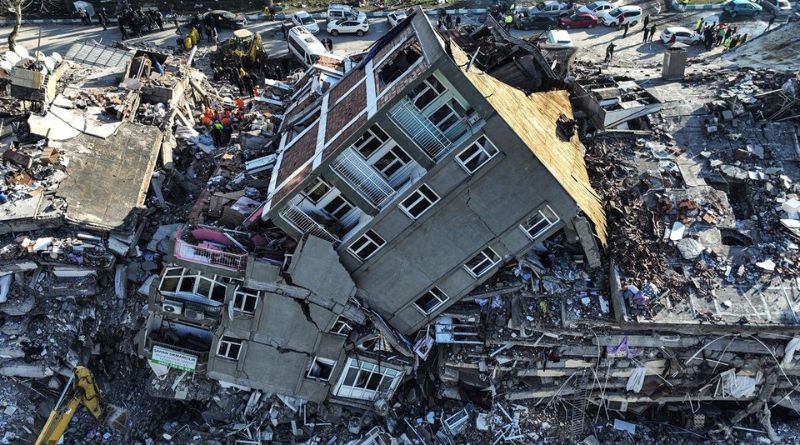According to the National Earthquake Information Center, there is an average of 20,000 earthquakes each year —16 of them being major disasters.
 By: SB Qureshii
By: SB Qureshii
How to prevent earthquakes and reduce the expected damages?
Earthquakes are one of the Earth’s most destructive forces — the seismic waves throughout the ground can destroy buildings, take lives, and costs tremendous amounts of money for loss and repair.
Its has been seen a 6.2 magnitude earthquake in Islamabad Pakistan today, marking FIFTH Asian earthquake in the past week. Just a day before, a huge 7.2 magnitude earthquake hit Tajikistan, Japan and China. Syria and Turkey, other side, alone going through a massive destruction after recent earthquakes. A huge number of deaths and earthquake effectuates can be seen in videos. Eight major cities in Turkey have been reduced to rubble due to the recent earthquake. A large number of its public is on the road while turkiye is still facing horrific after shocks.
World Earthquake Report past 24 hours: 1 quake 6.0+, 1 quake 5.0+, 35 quakes 4.0+, 163 quakes 3.0+, 377 quakes 2.0+
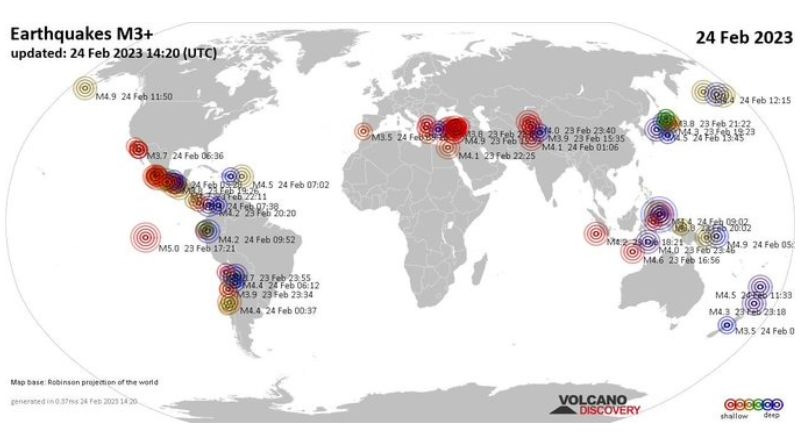
On Feb. 6, a magnitude 7.8 earthquake occurred in southern Turkey near the northern border of Syria. This quake was followed approximately nine hours later by a magnitude 7.5 earthquake located around 59 miles (95 kilometers) to the southwest. As of Feb. 18, at least 5,700 aftershocks have occurred according to Turkey’s Disaster and Emergency Management Authority (AFAD).
On Feb. 20, a 6.4 magnitude earthquake killed three people and injured 213 in southern Turkey. The Feb. 6 earthquake was the most devastating to hit earthquake-prone Turkey in more than 20 years and was as strong as one in 1939, the most powerful recorded there
Rescue teams from different countries are doing rescue operation in Turkiye and Syria. Food supplies and necessary living conditions are being provided to these victims but they need more. This is the time to support them, definitely these people will build their homes again, will go on further to their lives. There is no replicate of their loved ones they lost in earthquake. A number of heart breaking scenes are seen here. A father holding his daughter’s hand under the rubble knowing that she is no more. A little girl protecting her brother under the rubble and saying to rescue man to save his life. In return she will do anything for him. Many of such HEART BREAKING scenes !
8th Oct 2005: Darkest Day in Pakistan’s History
One of the darkest days in Pakistan is October 08, 2005 when there has been a loss of more than 90,000 loss to human lives, 150,000 got injured and more than 2.8 million left with no shelter. Not only to Pakistan, but Nepal, Bangladesh, Sri Lanka and India also got affected.
Though these are natural disasters and human have nothing to do it but they can take preventive measures. Unfortunately people often fail to prepare themselves or their homes from earthquake damage. Being prepared will save your time and money in the event of an earthquake.
Earthquake and It’s Measures
To avoid any loss or damages by earthquake, buildings must be designed to absorb these shocks. We live in 21st century where a human have got access to the other planets, these creatures have also worked a lot on measures to resist these earthquakes and aftershocks. Over the past few decades, engineers have introduced new designs and building materials to better equip buildings to withstand earthquakes.
Earthquake’s Impact
Earthquake-resistant Structures are structures designed to protect buildings from earthquakes. While no structure can be entirely immune to damage from earthquakes, the goal of earthquake-resistant construction is to erect structures that fare better during seismic activity than their conventional counterparts. According to building codes, earthquake-resistant structures are intended to withstand the largest earthquake of a certain probability that is likely to occur at their location. This means the loss of life should be minimized by preventing collapse of the buildings for rare earthquakes while the loss of the functionality should be limited for more frequent ones.
It’s important to understand how earthquakes impact man-made structures. When an earthquake occurs, it sends shockwaves throughout the ground in short rapid intervals in all different directions. While buildings are generally equipped to handle vertical forces from their weight and gravity, they cannot handle side-to-side forces emitted by quakes.
To design an earthquake-proof building, engineers need to reinforce the structure and counteract an earthquake’s forces. Since earthquakes release energy that pushes on a building from one direction, the strategy is to have the building push the opposite way. Here are some of the methods used to help buildings withstand earthquakes.
Flexible Foundation
One way to resist ground forces is to “lift” the building’s foundation above the earth. Base isolation involves constructing a building on top of flexible pads made of steel, rubber, and lead. When the base moves during the earthquake, the isolators vibrate while the structure itself remains steady. This effectively helps to absorb seismic waves and prevent them from traveling through a building.

You might be aware that cars have shock absorbers. However, you might not know that engineers also use them for making earthquake-resistant buildings. Similar to their use in cars, shock absorbers reduce the magnitude of shockwaves and help buildings slow down. This is accomplished in two ways: vibrational control devices and pendulum dampers.
Vibration Control Devices
This method involves placing dampers at each level of a building between a column and beam. Each damper consists of piston heads inside a cylinder filled with silicone oil. When an earthquake occurs, the building transfers the vibration energy into the pistons, pushes against the oil. The energy is transformed into heat, dissipating the force of the vibrations.
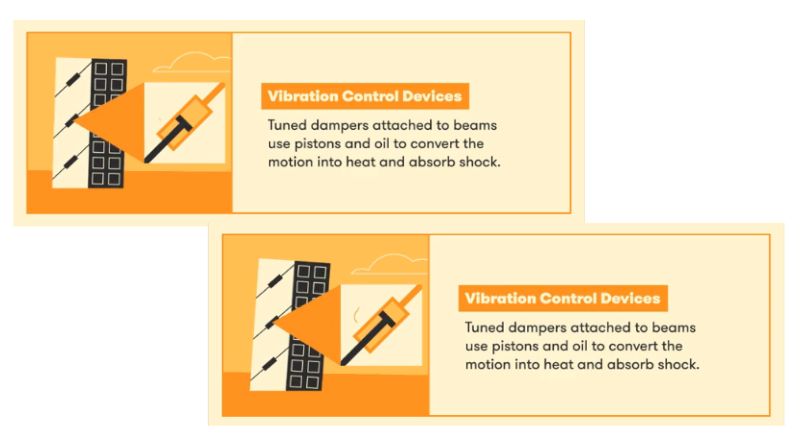
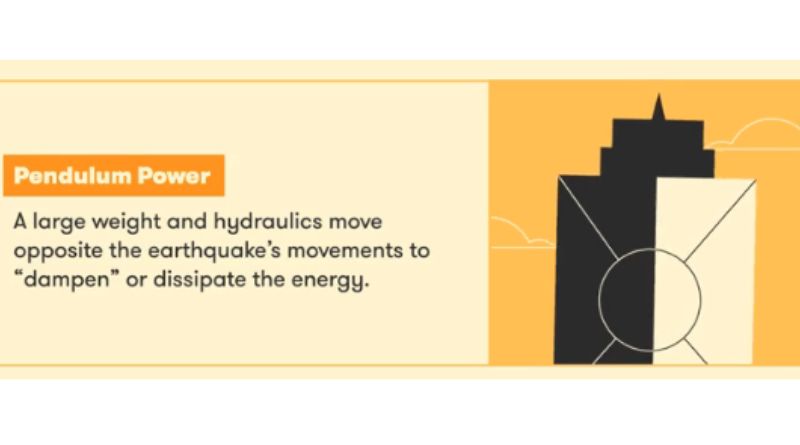
Pendulum Power is another damping method is pendulum power, used primarily in skyscrapers. Engineers suspend a large ball with steel cables with a system of hydraulics at the top of the building. When the building begins the sway, the ball acts as a pendulum and moves in the opposite direction to stabilize the direction. Like damping, these features are tuned to match and counteract the building’s frequency in the event of an earthquake. These kinds of building structures were first built in Japan.
Shield Buildings from Vibrations
Instead of just counteracting forces, researchers are experimenting with ways buildings can deflect and reroute the energy from earthquakes altogether. Dubbed the “seismic invisibility cloak”, this innovation involves creating a cloak of 100 concentric plastic and concrete rings in and burying it at least three feet beneath the foundation of the building. As seismic waves enter the rings, they are forced to move through to the outer rings for easier travel. As a result, they are essentially channeled away from the building and dissipated into the plates in the ground.
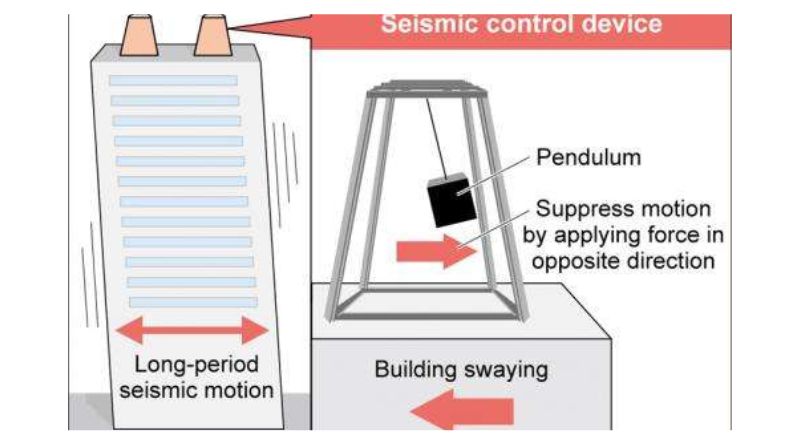
Reinforce the Building’s Structure
To withstand collapse, buildings need to redistribute the forces that travel through them during a seismic event. Shear walls, cross braces, diaphragms, and moment-resisting frames are central to reinforcing a building.
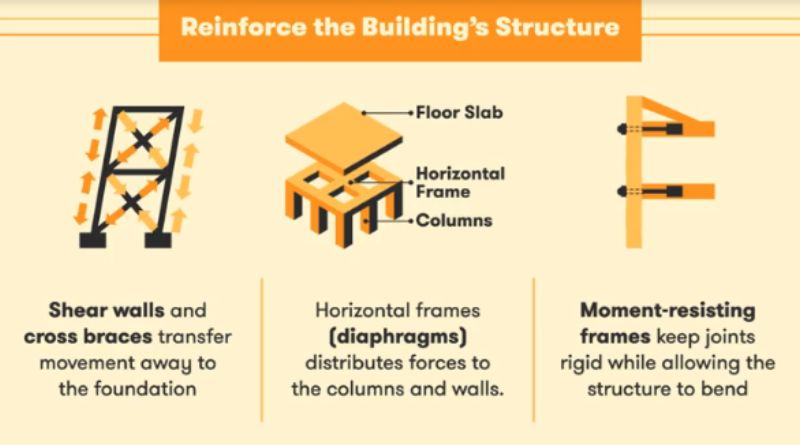
- Shear walls are a useful building technology that helps to transfer earthquake forces. Made of panels, these walls help a building keep its shape during movement. Shear walls are often supported by diagonal cross braces. These steel beams have the ability to support compression and tension, which helps to counteract the pressure and push forces back to the foundation.
- Diaphragms are a central part of a building’s structure. Consisting of the floors of the building, the roof, and the decks placed over them, diaphragms help remove tension from the floor and push force to the vertical structures of the building.
- Moment-resisting frames provide more flexibility in a building’s design. This structure is placed among the joints of the building and allows for the columns and beams to bend while the joints remain rigid. Thus, the building is able to resist the larger forces of an earthquake while allowing designers more freedom to arrange building elements
For a building material to resist stress and vibration, it must have high ductility — the ability to undergo large deformations and tension. Modern buildings are often constructed with structural steel — a component of steel that comes in a variety of shapes that allow buildings to bend without breaking. Wood is also a surprising ductile material due to its high strength relative to its lightweight structure.
Scientists and engineers are developing new building materials with even greater shape retention. Innovations like shape memory alloys have the ability to both endure heavy strain and revert to their original shape, while fiber-reinforced plastic wrap — made by a variety of polymers — can be wrapped around columns and provide up to 38% greater strength and ductility.
Engineers are also turning to natural elements. Over the years, engineers and scientists have devised techniques to create some effective earthquake-proof buildings. As advanced the technology and materials are today, it is not yet possible for building to completely withstand a powerful earthquake unscathed. Still, if a building is able to allow its occupants to escape without collapsing and saves lives and communities, we can consider that a great success.
